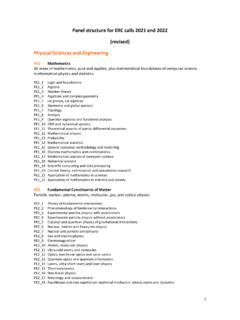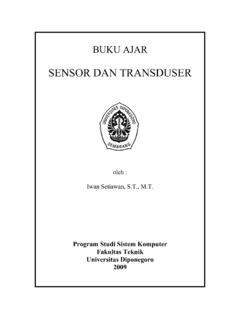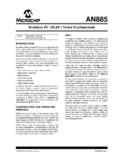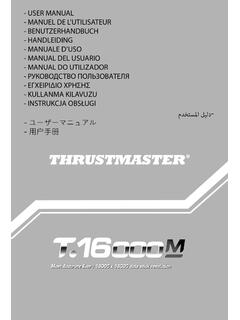Transcription of AD22151 Linear Output Magnetic Field Sensor Data Sheet ...
1 REV. AInformation furnished by Analog Devices is believed to be accurate andreliable. However, no responsibility is assumed by Analog Devices for itsuse, nor for any infringements of patents or other rights of third parties thatmay result from its use. No license is granted by implication or otherwiseunder any patent or patent rights of Analog Devices. Trademarks andregistered trademarks are the property of their respective Technology Way, Box 9106, Norwood, MA 02062-9106, : 781/329-4700 : 781/326-8703 2003 Analog Devices, Inc. All rights OutputMagnetic Field SensorFEATURESA djustable Offset to Unipolar or Bipolar OperationLow Offset Drift over Temperature RangeGain Adjustable over Wide RangeLow Gain Drift over Temperature RangeAdjustable First Order Temperature CompensationRatiometric to VCCAPPLICATIONSA utomotiveThrottle Position SensingPedal Position SensingSuspension Position SensingValve Position SensingIndustrialAbsolute Position SensingProximity SensingFUNCTIONAL BLOCK DIAGRAMTEMP REFISOURCEDEMODSWITCHESOUT AMPREFVCC/2AD22151 GENERAL DESCRIPTIONThe AD22151 is a Linear Magnetic Field transducer.
2 The sensoroutput is a voltage proportional to a Magnetic Field appliedperpendicularly to the package top Sensor combines integrated bulk hall cell technology andinstrumentation circuitry to minimize temperature related driftsassociated with silicon hall cell characteristics. The architecturemaximizes the advantages of a monolithic implementation whileallowing sufficient versatility to meet varied application require-ments with a minimum number of features include dynamic offset drift cancellationand a built-in temperature Sensor . Designed for single 5 Vsupply operation, the AD22151 achieves low drift offset andgain operation over 40 C to +150 C. Temperature compensa-tion can accommodate a number of Magnetic materials commonlyutilized in economic position Sensor transducer can be configured for specific signal gains tomeet various application requirements.
3 Output voltage can beadjusted from fully bipolar (reversible) Field operation to fullyunipolar Field voltage Output achieves near rail-to-rail dynamic range,capable of supplying 1 mA into large capacitive loads. Thesignal is ratiometric to the positive supply rail in all = NO FFigure 1. Typical Bipolar Configuration with Low(< 500 ppm) CompensationNCR1 GNDR3R2 VCCAD22151NC = NO FR4 Figure 2. Typical Unipolar Configuration withHigh ( 2000 ppm) CompensationREV. A 2 AD22151 SPECIFICATIONS (TA = 25 C and V+ = 5 V, unless otherwise noted.)ParameterMinTypMaxUnitOPERATIONVC C (Pin 3) Sensitivity/Volt160mV/G/VInput Range1 VCC205 .VOUTPUT2 Sensitivity (External Adjustment, Gain = +1) Output Range1090% of VCCO utput of VCCO utput Max (Clamp)93% of VCCD rive @ 0 Gauss VCC2 VOffset Adjust of VCCO utput Short Circuit (10% to 90% Range) FSGain Error (Over Temperature Range) 1%Offset Error (Over Temperature Range) Gain TC (GTCU)950ppmRATIOMETRICITY dB ROLL-OFF (5 mV/G) NOISE FIGURE (6 kHz BW) SOICOPERATING TEMPERATURE RANGE 40+150 CNOTES1 40 C to +150 = subject to change without (electrostatic discharge) sensitive device.
4 Electrostatic charges as high as 4000 V readilyaccumulate on the human body and test equipment and can discharge without detection. Although theAD22151 features proprietary ESD protection circuitry, permanent damage may occur on devicessubjected to high energy electrostatic discharges. Therefore, proper ESD precautions are recommendedto avoid performance degradation or loss of MAXIMUM RATINGS*Supply Voltage .. 12 VPackage Power Dissipation .. 25 mWStorage Temperature .. 50 C to +160 COutput Sink Current, IO .. 15 mAMagnetic Flux Density .. UnlimitedLead Temperature (Soldering 10 sec) .. 300 C*Stresses above those listed under Absolute Maximum Ratings may cause perma-nent damage to the device. This is a stress rating only; functional operation of thedevice at these or any other conditions above those indicated in the operationalsections of this specification is not implied.
5 Exposure to the absolute maximumrating conditions for extended periods may affect device GUIDET emperaturePackagePackageModelRangeDescri ption OptionAD22151YR 40 C to +150 C8-Lead SOIC R-8AD22151YR-REEL 40 C to +150 C8-Lead SOIC R-8 REV. AAD22151 3 PIN CONFIGURATIONTOP VIEW(Not to Scale)87651234 AREA OF SENSITIVITY* TC1TC2TC3 GNDVCCREFGAINOUTPUTAD22151(Not to Scale)87651234*SHADED AREA REPRESENTS Magnetic Field AREA OF SENSITIVITY (20 MILS 20 MILS) POSITIVE B Field INTO TOP OF PACKAGE RESULTS IN A POSITIVE VOLTAGE RESPONSE CIRCUIT OPERATIONThe AD22151 consists of epi hall plate structures located at thecenter of the die. The hall plates are orthogonally sampled bycommutation switches via a differential amplifier. The twoamplified hall signals are synchronously demodulated to provide aresultant offset cancellation (see Figure 3).
6 The demodulatedsignal passes through a noninverting amplifier to provide finalgain and drive capability. The frequency at which the outputsignal is refreshed is 50 C140 40120100806040200 20 V 3. Relative Quiescent Offset vs. TemperatureTEMPERATURE DEPENDENCIESThe uncompensated gain temperature coefficient (GTCU) of theAD22151 is the result of fundamental physical properties asso-ciated with silicon bulk hall plate structures. Low doped Hallplates operated in current bias mode exhibit a temperaturerelationship determined by the action of scattering mechanismsand doping relative value of sensitivity to Magnetic Field can be alteredby the application of mechanical force upon silicon. The mecha-nism is principally the redistribution of electrons throughout thePIN FUNCTION DESCRIPTIONSPin Compensation 1 Output2 Temperature Compensation 2 Output3 Temperature Compensation 3 Input/Output4 Ground5 OutputOutput6 GainInput7 ReferenceOutput8 Positive Power Supply valleys of the silicon crystal.
7 Mechanical force on the Sensor isattributable to package-induced stress. The package materialacts to distort the encapsulated silicon, altering the hall cellgain by 2% and GTCU by 200 4 shows the typical GTCU characteristic of the is the observable alteration of gain with respect to tempera-ture with Pin 3 (TC3) held at a constant V (uncompensated).If a permanent magnet source used in conjunction with thesensor also displays an intrinsic TC (BTC), it will require factoringinto the total temperature compensation of the Sensor 5 and 6 represent typical overall temperature/gain per-formance for a Sensor and Field combination (BTC = 200 ppm).Figure 5 is the total drift in volts over a 40 C to +150 C tem-perature range with respect to applied Field . Figure 6 representstypical percentage gain variation from 25 C.
8 Figures 7 and 8show similar data for a BTC = 2000 C14 4 40% GAIN106011016012420 21068 6 Figure 4. Uncompensated Gain Variation (from25 C) vs. TemperatureREV. A 4 AD22151 Field Gauss 600400 400 20002000 DELTA SIGNAL 5. Signal Drift over Temperature ( 40 C to+150 C) vs. Field ( 200 ppm); 5 V SupplyTEMPERATURE 401060110160 6. Gain Variation from 25 C vs. Temperature( 200 ppm) Field ; R1 15 kWFIELD Gauss 600400 400 2000200 DELTA SIGNAL 800800 Figure 7. Signal Drift over Temperature ( 40 C to+150 C) vs. Field ( 2000 ppm); 5 V SupplyTEMPERATURE 401060110160 GAINF igure 8. Gain Variation (from 25 C) vs. Temperature( 2000 ppm Field ; R1 = 12 kW)TEMPERATURE COMPENSATIONThe AD22151 incorporates a thermistor transducer thatdetects relative chip temperature within the package.
9 Thisfunction provides a compensation mechanism for the varioustemperature dependencies of the hall cell and magnet combina-tions. The temperature information is accessible at Pins 1 and2 ( +2900 ppm/ C) and Pin 3 ( 2900 ppm/ C), as repre-sented by Figure 9. The compensation voltages are trimmedto converge at VCC/2 at 25 C. Pin 3 is internally connected tothe negative TC voltage via an internal resistor (see the Func-tional Block Diagram). An external resistor connected betweenPin 3 and Pins 1 or 2 will produce a potential division of thetwo complementary TC voltages to provide optimal compensa-tion. The Pin 3 internal resistor provides a secondary TCdesigned to reduce second order hall cell temperature 2 40 , TC2 VOLTSTC3 VOLTSF igure 9. TC1, TC2, and TC3 with Respect to Referencevs.
10 TemperatureThe voltages present at Pins 1, 2, and 3 are proportional to thesupply voltage. The presence of the Pin 2 internal resistor dis-tinguishes the effective compensation ranges of Pins 1 and 2.(See temperature configuration in Figures 1 and 2, and typicalresistor values in Figures 10 and 11.)Variation occurs in the operation of the gain temperature com-pensation for two reasons. First, the die temperature within thepackage is somewhat higher than the ambient temperature dueREV. AAD22151 5 to self-heating as a function of power dissipation. Second, pack-age stress effect alters the specific operating parameters of thegain compensation, particularly the specific crossover tempera-ture of TC1, TC3 ( 10 C).CONFIGURATION AND COMPONENT SELECTIONT here are three areas of Sensor operation that require externalcomponent selection: temperature compensation (R1), signalgain (R2 and R3), and offset (R4).














